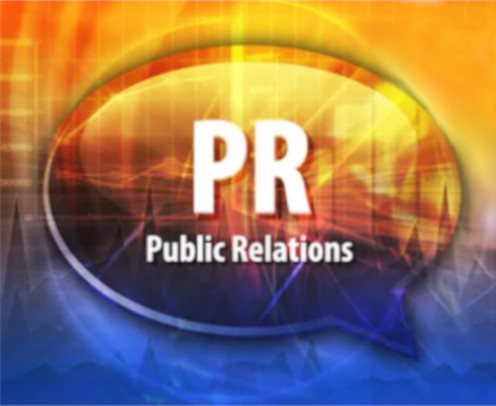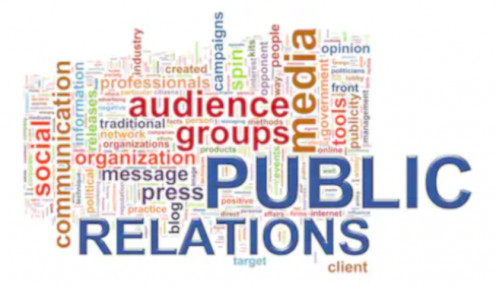Intro to Public Relations

Public relations activities help to create and to maintain a strong and positive image for a company or an organization. Public relations efforts (called “PR”) can be designed to benefit a particular product or service, but, at the same, are always concerned with improving and maintaining overall perceptions on the part of one or more “publics,” for a company or an organization.
As someone who has worked as a marketing communications professor and as a marketing communications professional, for decades, I know that while the PR function is taught in schools of journalism and media communications and is news-oriented in nature, the practice of public relations is actually part of what is known as "the marketing mix." The famous “4P’s” of marketing include product, price, place (distribution), and promotion. And, underneath the promotion “P,” is advertising, public relations, publicity, and sales promotion.

The Many “Publics” of Public Relations
Companies have many publics, and, those that understand and appreciate the value of good public relations develop strategic marketing plans that include a PR component for all of their major publics. The main difference is whether a public is external to the company, or internal.
First, we’ll take a look at some of the possible external publics of a company or organization. The most important among these is always the “customer public.” This includes people who either already patronize the company or purchase/use its products or services, and those the company sees as “potential” customers.
Next, there is the general public. The general public includes anyone located where a company's products/services are distributed or sold—locally, regionally, or nationally—that might influence its ability to achieve marketing objectives.This includes the local public, that is, people who live where the company is located or where its products or services are manufactured. A local public includes neighborhood residents as well as community organizations.
Other external publics include:
- Financial publics: People with the ability to influence or impact a company’s access to credit and/or its ability to obtain funds.
- Media publics: Professionals with the ability to publish news, features, and editorial opinions about a company that can affect or influence what others believe about the company.
- Government publics: Those with the ability to affect the company or its products/services through legislation and laws that could regulate or restrict product manufacturing or marketing efforts.
- Citizen-action publics: Organized groups with special interests who could question the actions of a company, potentially placing it in the public spotlight.

And last, but certainly not least, is the company’s internal publics. These include employees, executives, managers, volunteers, and members of the boards of directors, those who, through their work, keep the company producing products and/or delivering services. Internal publics are just as important as external ones, and should never be taken for granted.

Non-Profit "Publics"
In terms of publics, the non-profit organization has to consider the same groups as for-profit companies and organizations, but there are usually two very distinct primary “public” audiences. The first distinct public audience comprises recipients of whatever services the organization provides.
Because many in this group can be reluctant to apply for or to accept services (due to social stigma, fear of public identification or other factors), efforts must be taken to create a positive image that can generate favorable responses to what the organization provides. For example, organizations such as addiction recovery programs must reinforce the image of a positive, non-judgmental entity that respects the right to privacy of those receiving services.
Another distinct and vitally important public group for the non-profit organization is the pool of potential donors in the community. And don't think this just includes those who can donate "big money." People capable and willing to donate small amounts far outnumber those with lots of cash, and they tend to be loyal and dedicated givers too. When it comes to donors, big money philanthropists and individuals with smaller amounts of cash to give, non-profits must be very conscious of image.
The opinions that donors and potential donors form about an organization matter, because they provide the financial resources enabling the organization to operate. Therefore, non-profit organizations must maintain and reinforce, at all times, an image of the organization as honest, transparent, efficient, hard-working, and a provider of effective and beneficial services that are helping to create a stronger and better community.

What is Publicity and Why is It Part of Public Relations?
Even the word "publicity" can conjure up negative images of pesky paparazzi hound-dogging Hollywood stars in search of the perfect photo op. Still, publicity is a device inside the toolkit of public relations practitioners, and it seeks to attract positive attention for a company, a product, an individual, or an event.
A third party—usually a mass media source—is often utilized to generate publicity. Unlike advertising, publicity is unpaid and usually uncontrolled. It is a type of promotion that involves the mentioning of the organization by the mass media, with the company’s objective being to create or to further a positive image. And even though companies control the content of information they send to the media (through their own PR agents or publicists), ultimately, they have no control over its placement or interpretation by the media.
A charitable organization might have only a small portion of its overall budget available for paid public relations and marketing efforts. For this reason, publicity is one of the primary tools of many non-profits; it is what they depend on to help them communicate their story; what determines if their message will be told about their effectiveness, helping them to attract both donors and clients for their services.
While the actions and activities of any company or organization can result in positive publicity, any negative actions or activities involving these entities in any way can result in bad publicity, and will reflect poorly on the company’s image.
The same is true for non-profits. Employees, board members, and even volunteers who engage in improper activities when they’re not actually doing work for the organization, can cause negative publicity and potentially destroy or weaken public trust in the non-profit. For this reason, much care must be taken in selecting volunteers and other personnel to work for the non-profit organization.
Media sources are always interested in reporting on “human interest stories,” profiling good deeds done by companies, their employees, and volunteers of charitable organizations. The media will eagerly publish reports on success stories of those who've helped as well as those who have been helped, in profound ways, by a company’s products or services. When it comes to non-profits, fundraising events provide additional opportunities for exposure in the “society news” of community media outlets and other news sources.

Objective Difference: Public Relations and Marketing
Marketing is a process used to connect consumers who have identifiable needs and desires, with products and services developed to satisfy those needs and desires. The intent of marketing is to place focus on the goods or services a company produces or provides, while public relations is mainly concerned with the overall image that is created for the company, in the minds of its publics.
Advertising, the most prevalent form of marketing communications, is a paid media message that is controlled by a company in terms of message timing, positioning and content. By comparison, publicity is unpaid exposure in the media, with no direct control by the company. A common objective of public relations is to attempt to influence publicity, as well as to respond to publicity, whether it is favorable or unfavorable, when it occurs.
For many donors, the public image and reputation of a charitable organization is something that assists in making decisions about where resources will be donated. Since it is known that companies and organizations control the content of paid messages, marketing communications materials are viewed as inherently biased by members of the public.
Publicity, on the other hand, is usually perceived as being less biased since it is controlled by media personnel rather than by companies or organizations, and can be positive and/or negative. When well-implemented and properly managed, positive publicity can help to improve the public image and reputation of the organization as well as its executives and employees, thereby increasing its overall attractiveness to potential donors.

The "Seven C's" of Effective Communications
In 1952, Scott Cutlip and Alan Center published a book (Effective Public Relations) that became known as "the bible" for many public relations practitioners. Although the book has been updated many times, the “Seven C’s”, as developed by Cutlip, Center & Broom, are still commonly used as a guide for developing effective public relations communications. In fact, risk and crisis communications plans are often developed using these principles. The seven factors that are still the basis of most effective communications include:
- Credibility – the source of communications must be seen as believable, reputable and competent to report on the matter at hand.
- Context – Communications should be tailored to work in conjunction with existing image and/or positive publicity, while also preparing counters for any negative image/publicity. This is particularly true when communicating during a crisis or during an incident resulting in negative publicity.
- Content – Communications messages must be tailored to speak to a specific audience. Relevant content should be carried by a message source easily accessible by the audience(s).
- Clarity – Message should be clear and unambiguous. Care should be taken to choose words and phraseology to convey meaning and message intent.

- Continuity and Consistency – Subsequent communications messages should be developed to repeat and serve as reinforcement. Message consistency is crucial. Contradictory messages from the same source can seriously damage perception of the competence and credibility of the source.
- Channels – Consider as many avenues as possible for communications. Some channels (such as different print, television, Internet, and radio outlets) cater to particular audiences, and some (including respected journalists and/or publications) enhance the credibility of the message.
- Capability (Consider your audience) – Communications are most effective when they require the least amount of effort to read and to comprehend, on the part of the recipient. Messages should be oriented toward the language and vocabulary of the target audience.
Reference
Cutlip, S.M., Center, A.H. and Broom, G.M. (2005). Effective Public Relations. 9th ed. Prentice-Hall, Englewood Cliffs, New Jersey.
© 2012 Sallie B Middlebrook PhD








